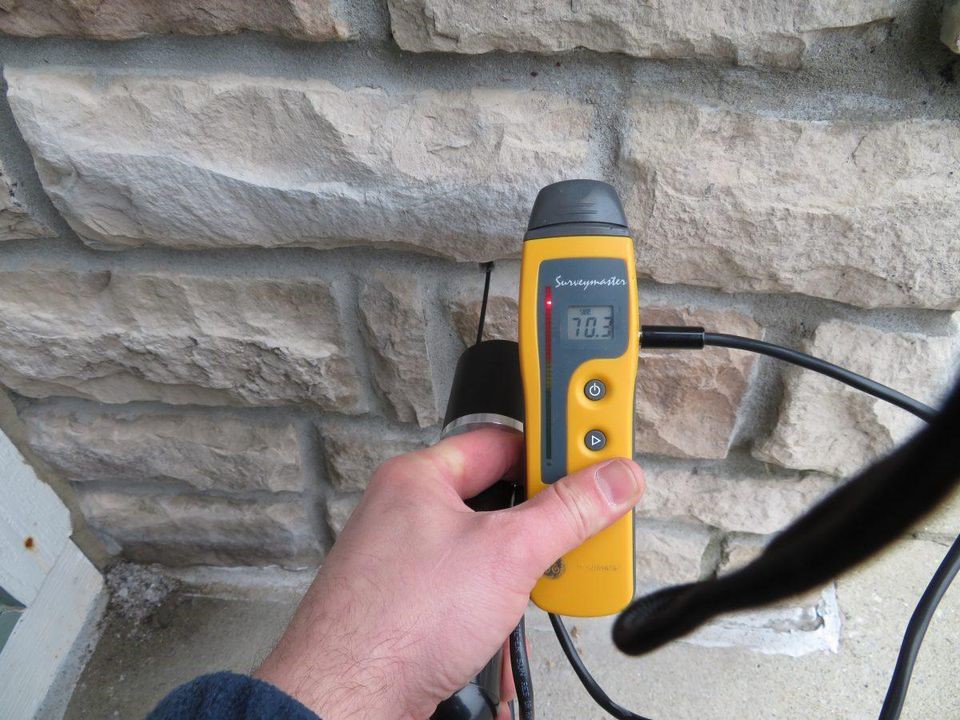Stone Veneer Siding: Looks Great, But Bad Installations Cost Unlucky Homeowners Thousands
by Jim Morrison 9/14/2018Forbes.com

Ben Hendricks, of ABI Home Services finds elevated moisture level in wall behind stone veneer siding that shows no outward signs of leakingABI Home Services
Stone veneer siding is increasingly popular because it has the attractive look of real stone at a fraction of the cost. Unfortunately, experts say it is very often installed improperly and those hard-to-find installation defects can cause tens of thousands of dollars of structural damage to a home. By the time a homeowner suspects a problem, it’s usually already way too late.
Cliff Kapson, an exterior siding consultant from Chicago with a nationwide network of stone veneer siding inspectors said his network does about 250 stone veneer siding inspections every month and more than 90% of them are not installed in accordance with the industry standard from the National Concrete Masonry Association.
“The biggest problems I see are: missing kick-out flashings and missing backer rod and sealant joints around windows,” Kapson said. “The stone veneer system is a plaster wall assembly. We usually see the stone right up against the window or there’s mortar right up against the window.”
Most people are surprised to learn the exterior siding on a house is not water-tight. Water is expected to penetrate the siding and must be managed. If the siding isn’t designed or installed properly, the water will remain in the wall and cause expensive structural damage over time.
Experts say bad installations and the damage from a bad installation isn’t immediately evident.
“We’re looking at new homes and 2-3 year old homes and we don’t get elevated moisture readings,” Kapson said. “But these same defects in 10-14 year old homes experience major moisture and damage issues. Our experience is: it’s not a question of if the defects will result in damage, but when.”
Kapson likes the product and said it doesn’t leak when installed correctly. The leaks come from bad installations and they most often come around transitions at windows and penetrations, like around exterior light fixtures. His siding evaluations generally cost between $1,000 and $2,000 (depending on the size and location). He routinely discovers bad installations that can cost tens of thousands of dollars to repair.
Ben Hendricks owns ABI Home Inspection Services in Louisville, KY. He said he’s never seen stone veneer siding installed properly and thinks it’s going to be the next big thing in real estate. He’s written several blog posts about his experience with this siding on his web site.
“There is a ten-step process to install this stuff and when builders skip steps 3-5, there’s no way to fix it without tearing it off and starting all over,” Hendricks said. “The first time I came across this problem, it cost the owner $80,000 to repair the siding and damage on a $600,000 house.”
Hendricks called the problem a "pandemic” and said the siding has been popular in Greater Louisville for about ten years. Now that the earlier installations are hitting the age where owners are discovering problems, he thinks the number of people reporting problems is about to mushroom.
Jason Thompson is the vice president of Engineering at the National Concrete Masonry Association. He said his experience mirrors the above inspectors’ and added that defective installations cause more damage, sooner in wetter climates.
“In areas with less rainfall, moisture stays hidden for years and by the time it has manifested on the interior 10 years or so later, that’s when the wall comes apart in your hand,” Thompson said.
The bottom edge of stone veneer siding should ideally stop 6 inches above the ground to allow moisture that gets past the siding to drain out, according to Thompson. He said many homeowners will insist that builders install the siding right down to the soil, which impedes drainage and can allow moisture to wick up the wall, all but ensuring rot and mold in the walls.
“Most good contractors will refuse to do that,” Thompson said. “But some will do it if the owner signs something saying the owner accepts responsibility for it.”
Each of the experts interviewed for this story recommended that homeowners who think they might have a problem with the stone veneer siding on their house get an inspection from an experienced, qualified expert. It can be expensive, but it might save them thousands of dollars in repair bills.
Anyone considering having stone veneer siding on their home, should ensure it is done in strict accordance with the recognized industry standards.

